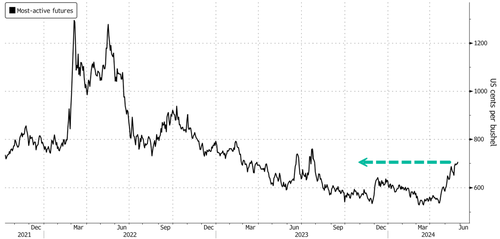Wheat Jumps To Nine-Month High On Fears Of Dwindling Global Stockpiles
During the Memorial Day holiday break, food inflation was certainly on the minds of those who had to purchase beef patties and other BBQ-related items for outdoor parties. The Biden administration has deflected rampant food inflation on ‘greedy’ corporations, but more likely due to supply constraints. Beef and egg prices are climbing, and staples like orange juice, cocoa beans, and coffee are skyrocketing. Now, the latest soft commodity that is pushing higher is wheat.
Bad weather across the world’s top growing regions, including the driest May in Ukrainian records, lack of rainfall in Western Australia, and unseasonably cold weather in Russia, has sent wheat futures in Chicago to a nine-month high.
Here are the top growing regions experiencing adverse weather conditions (courtesy of Bloomberg):
Black Sea Dryness: Top exporter Russia risks missing out on crucial moisture, with weeks of heat and not enough rain in the country’s south prompting analysts to cut harvest estimates. Half Russia’s winter wheat will remain too dry over the next two weeks, Commodity Weather Group said Wednesday. Russia should still reap a big crop, but its dominance means that any jolts to local prices feed through to other markets — and the country’s wheat has been getting more expensive lately.
War in Ukraine: Dryness has also hampered swaths of Ukraine’s wheat in recent weeks, but war is fueling other problems. Attacks on agriculture infrastructure threaten exports and the workforce has been depleted as men serve in the army. Grain output in the upcoming season could drop 6% from a year earlier with farmers expected to divert grain acres to more profitable crops like rapeseed.
Wet Western Europe: A soggy spring hurt crop development across northwest Europe. Winter-crop quality — which determines whether supplies are used for food or for animal feed — could also suffer. In France, the share of wheat and barley in top conditions lags far behind last year’s level. Rain has also slowed spring plantings in the UK, Germany and France. “We are obviously concerned by the issue of unplanted areas given it is linked to the weather conditions,” Benoit Pietrement, chair of the grains council at crops office FranceAgriMer, said last month.
Parched Australia: A dry, hot summer in parts of Australia has dried up soil just as farmers plant the crop. While recent rain provided a bit of relief in some areas of the key state of Western Australia, growers remain cautious. Crops risk “frying” in the state if rain stops after germination, Dennis Voznesenski, associate director of sustainable and agricultural economics at Commonwealth Bank of Australia, said this week. Wheat’s rally both locally and globally has been faster than expected, he said.
Dry US: Drought has gripped a bigger share of US winter-wheat fields since early April, and remains a concern for spring plantings, even as recent forecasts indicate showers. Still, more US winter wheat is in the top conditions than usual for this time of year and spring plantings remain ahead of the five- year average pace. Crop concerns are showing up in prices, with money managers now the least bearish since July. But things could change before the first Northern Hemisphere harvests start in roughly four weeks. There is “a lot of weather to trade yet, the crop is far from being complete and if rains show up they will have value,” said Matt Ammermann, a commodity risk manager at StoneX. “It now remains a wait-and-see type of game.”
Wheat futures jumped 3.3% in early Asian trading but have since trended lower in Europe and the US. Prices are up about 2% around 0730 ET.
Bumper Black Sea harvests have capped prices in the last 1.5 years, but supply concerns are mounting as top growing regions, as noted above, are hit with adverse weather conditions, denting harvest forecasts. This led analysts to survey ahead of the US government’s wheat forecast to project the smallest global stockpiles in nearly a decade.
The dismal projection comes as hedge funds have been cutting back net bearish bets in Chicago.
Ole Houe, chief executive officer at broker and adviser IKON Commodities, told Bloomberg that the rally has been fueled by farmers holding onto stockpiles for higher prices: “Growers have all the power, and they are wielding it mercilessly.”
Looking at broader food indexes, especially the UN World Food Index, prices have increased marginally in recent months.
Meanwhile, spot commodity prices tracked by Bloomberg recently surged to levels not seen in 1.5 years.
Rising commodity prices have sparked a sense of nervousness in the Biden team ahead of the presidential elections.
Tyler Durden
Tue, 05/28/2024 – 13:20


Recent Comments